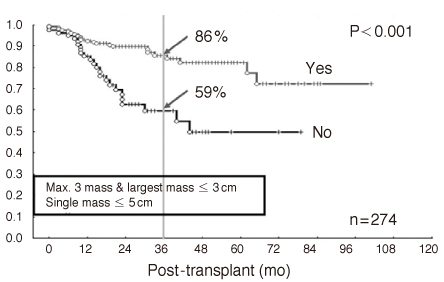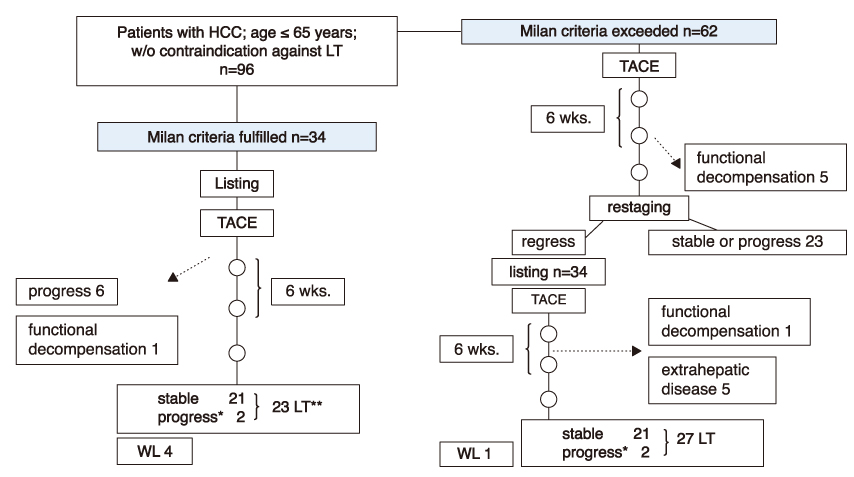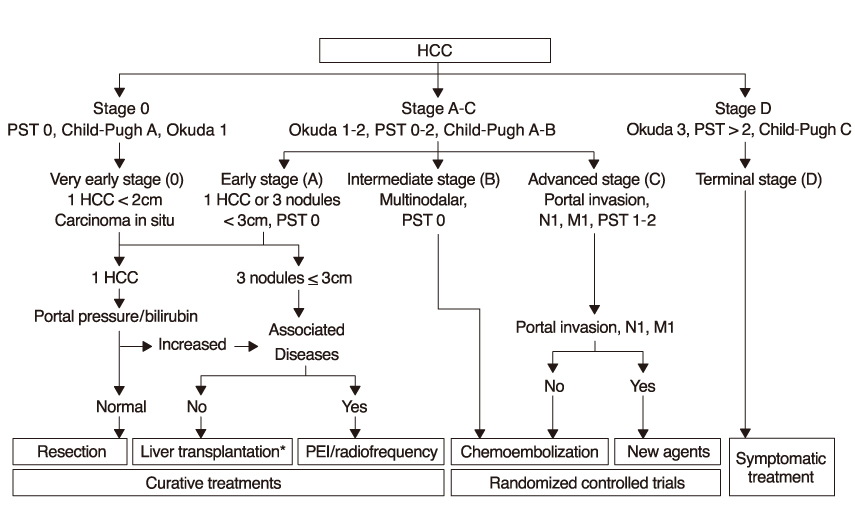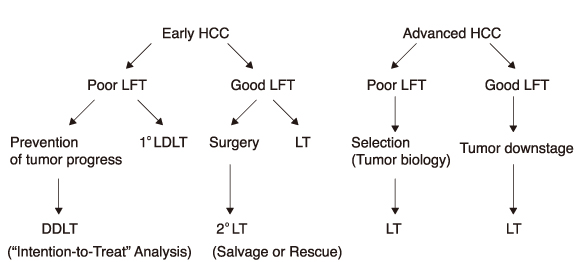J Korean Med Assoc.
2008 Aug;51(8):708-716. 10.5124/jkma.2008.51.8.708.
Indication and Outcome of Liver Transplantation In Patients with Hepatocellular Carcinoma
- Affiliations
-
- 1Department of Surgery, Seoul National University College of Medicine, Korea. kssuh@plaza.snu.ac.kr
- KMID: 2185928
- DOI: http://doi.org/10.5124/jkma.2008.51.8.708
Abstract
- Hepatocellular carcinoma (HCC) is the most common malignancy of the liver and most commonly associated with hepatitis B infection in Korea. Since HCC arises in cirrhotic livers and is often multicentric, liver transplantation (LT) seems to be a rational and effective approach. Furthermore hepatitis B can be eradicated after LT in more than 90% patients. Current selection criteria of LT for HCC are Milan criteria; single nodule < or = 5cm in diameter, or 3 nodules < or = 3cm each, without major vessel invasion, without extrahepatic metastasis. Patients within Milan criteria showed 75% 5-yeaer survival rate after LT, which was comparable to that of a transplant candidate without HCC. Expanding selection criteria result in more patients with HCC being cured at the expense of a higher incidence of recurrence. Because some, but not all patients with unresectable HCC more than 5cm in diameter have significant vascular invasion and high recurrence rate, this highlights the need to incorporate molecular/biologic information. Pretransplant transarterial chemoembolization and salvage transplantation had a role for down stage or biologic selection of HCC. However, these methods had many controversies about their indication and safety. Iindication of LT for HCC patients is similar in living donor LT. In Korea, living donor LT is more popular in LT for HCC and outcome is comparable to that in deceased donor liver transplantation. In the future, with better understanding of tumor biology, a more and better group of patients with HCC can be selected for LT.
Keyword
MeSH Terms
Figure
Reference
-
1. Chen MS, Li JQ, Zheng Y, Cuo RP, Liang HH, Zhang YQ, Lin XJ, Lau WY. A prospective randomized trial comparing percutaneous local ablation therapy and partial hepatectomy for small hepatocellular carcinoma. Ann Surg. 2006. 243:321–328.
Article2. Suh KS, Yi NJ. Liver Transplanation for hepatocellular carcinoma. Korean J Hepatol. 2006. 12:493–506.3. Adam R, Gaudio MD. Evolution of liver transplantation for hepatocellular carcinoma. J Hepatol. 2003. 39:888–895.
Article4. Ringe B, Pichlmayr R, Wittekind C, Tusch G. Surgical treatment of hepatocellular carcinoma: experience with liver resection and transplantation in 198 patients. World J Surg. 1991. 15:270–285.
Article5. Momenti EP, Klintmalm GB. Liver transplantation association with hepatocellular carcinoma: an update of the international tumor registry. Liver Transpl. 2002. 8:736–748.6. Mazzaferro V, Regalia E, Doci R, Andreola S, Pulvirenti A, Bozzetti F, Montalto F, Ammnatuna M, Morabito A, Gennari L. Liver transplantation for the treatment of small hepatocellular carcinomas in patients with cirrhosis. N Engl J Med. 1996. 334:693–699.
Article7. Yao FY, Ferrell L, Bass NM, Watson JJ, Bacchetti P, Venook A, Ascher NL, Roberts JP. Liver transplantation for hepatocellular carcinoma: expansion of the tumor size limits does not adversely impact survival. Hepatology. 2001. 33:1394–1403.
Article8. Llovet JM, Fuster J, Bruix J. Barcelona-Clinic Liver Cancer Group. The Barcelona approach: diagnosis, staging, and treatment of hepatocellular carcinoma. Liver Transpl. 2004. 10:S. 115–120.
Article9. Hwang S, Lee SG, Joh JW, Suh KS, Kim DG. Liver Transplantation for adult patients with hepatocellular carcinoma in Korea: comparison between cadaveric donor and living donor liver transplantation. Liver Transpl. 2005. 11:1265–1272.
Article10. Schwartz M. Liver transplantation for hepatocellular carcinoma. Gastroenterology. 2004. 127:S. 268–276.
Article11. Decaens T, Roudot-Thoraval F, Hadni-Bresson S, Meyer C, Guqenheim J, Durand F, Bernard PH, Boillot O, Sulpice L, Calmus Y, Hardwiqsen J, Ducerf C, Paqeaux GP, Dharancy S, Chazouilleres O, Cherqui D, Duvoux C. Impact of UCSF criteria according to pre- and post-OLT tumor features: analysis of 479 patients listed for HCC with a short waiting time. Liver Transpl. 2006. 12:1761–1769.
Article12. Bruix J, Sherman M. Practice Guidelines Committee, American Association for the Study of Liver Diseases. Management of hepatocellular carcinoma. Hepatology. 2005. 42:1208–1236.
Article13. Cillo U, Vitale A, Bassanello M, Boccagni P, Brolese A, Zanus G, Burra P, Fagiuoli S, Farinati F, Rugge M, D'Amico DF. Liver transplantation for the treatment of moderately or well-differentiated hepatocellular carcinoma. Ann Surg. 2004. 239:150–159.
Article14. Adam R, Azoulay D, Castaing D, Eshkenazy R, Pascal G, Hashizume K, Samuel D, Bismuth H. Liver resection as a bridge to transplantation for hepatocellular carcinoma on cirrhosis: a reasonable strategy? Ann Surg. 2003. 238:508–518.15. Shetty K, Timmins K, Brensinger C, Furth EE, Rattan S, Sun W, Rosen M, Soulen M, Shaked A, Reddy KR, Olthoff KM. Liver transplantation for hepatocellular carcinoma validation of present selection criteria in predicting outcome. Liver Transpl. 2004. 10:911–918.
Article16. Yang SH, Lee HW, Cho EH, Cho JY, Cho YB, Kim IH, Yi NJ, Lee KU. A revised scoring system utilizing serum alphafetoprotein levels to expand candidates for living donor transplantation in hepatocellular carcinoma. Surgery. 2007. 141:598–609.
Article17. Todo S, Furukawa H. Living donor liver transplantation for adult patients with hepatocellular carcinoma: experience in Japan. Ann Surg. 2004. 240:451–461.
Article18. Peng SY, Chen WJ, Lai PL, Jeng YM, Sheu JC, Hsu HC. High α-fetoprotein level correlates with high stage, early recurrence and poor prognosis of hepatocellular carcinoma: Significance of hepatitis virus infection, age, p53 and β-catenin mutations. Int J Cancer. 2004. 112:44–50.
Article19. Gondolesi GE, Roayaie S, Munoz L, Kim-Schluger L, Schiano T, Fishbein TM, Emre S, Miller CM, Schwartz ME. Adult living donor liver transplantation for patients with hepatocellular carcinoma: Expending UNOS priority criteria. Ann Surg. 2004. 239:142–149.
Article20. Lee SG, Hwang S, Moon DB, Ahn CS, Kim KH, Sung KB, Ko GY, Park KM, Ha TY, Song GW. Expanded indication criteria of living donor liver transplantation for hepatocellular carcinoma at one large-volume center. Liver Transpl. 2008. 14:935–945.
Article21. Yang SH, Suh KS, Lee HW, Cho EH, Cho JY, Cho YB, Yi NJ, Lee KU. The role of 18F-FDG-PET imaging for the selection of liver transplantation candidates among hepatocellular carcinoma patients. Liver Transpl. 2006. 12:1645–1650.22. Khan MA, Combs CS, Brunt EM, Lowe VJ, Wolverson MK, Solomon H, Collins BT, Di Bisceglie AM. Positron emission tomography of hepatocellular carcinoma. J Hepatol. 2000. 32:792–797.23. Marsh JW, Dvorchik I. Should we biopsy each liver mass suspicious for hepatocellular carcinoma before liver transplantation?-yes. J Hepatol. 2005. 143:558–562.
Article24. Marsh JW, Finkelstein SD, Demetris AJ, Swalsky PA, Sasatomi E, Bandos A, Subotin M, Dvorchik I. Genotyping of hepatocellular carcinoma in liver transplantation recipients adds predictive power for determining recurrence-free survival. Liver Transpl. 2003. 7:664–671.25. Woo HG, Park ES, Cheon JH, Kim JH, Lee JS, Park BJ, Kim W, Park SC, Chung YJ, Kim BG, Yoon JH, Lee HS, Kim CY, Yi NJ, Suh KS, Lee KU, Chu IS, Roskams T, Thorgeirsson SS, Kim YJ. Gene expression-based recurrence prediction of hepatitis B virus-related human Hepatocellular carcinoma. Clin Cancer Res. 2008. 14:2056–2064.
Article26. Llovet JM, Mas X, Aponte J, Fuster J, Navasa M, Christensen E, Rodés J, Bruix J. Cost-effectiveness of adjuvant therapy for hepatocellular carcinoma before liver transplantation. Gut. 2002. 50:123–128.
Article27. Pereira SP, Williams R. Limits to live transplantation in UK. Gut. 1998. 42:883–885.28. Freeman RB, Edwards EB, Harper AM. Waiting list removal rates among patients with chronic and malignant liver diseases. Am J Transpl. 2006. 6:1416–1421.
Article29. Lau WY, Leung TW, Ho SK, Chan M, Machin L, Lau J, Chan AT, Yeo W, Mok TS, Yu SC, Leung NW, Johnson PJ. Adjuvnat intra-arterial iodine-131-labelled lipiodol for respectable hepatocellular carcinoma: a prospective randomized trial. Lancet. 1999. 353:797–801.
Article30. Belghiti J, Panis Y, Farges O, Benhamou JP, Fekete F. Intrahepatic recurrence after resection of hepatocellular carcinoma complicating cirrhosis. Ann Surg. 1991. 214:114–117.
Article31. Yao FY. Expanded criteria for hepatocellular carcinoma: down-staging with a view to liver transplantation - yes. Semin Liver Dis. 2006. 26:239–247.
Article32. Poon RT, Fan ST, Lo CM, Liu CL, Wong J. Long-term survival and pattern of recurrence after resection of small hepatocellular carcinoma in patients with preserve liver function. Implication for a strategy for salvage transplantation. Ann Surg. 2002. 3:373–382.33. Otto G, Herber S, Heise M, Lohse AW, Monch C, Bittinger F, Hoppe-Lotichius M, Schuchmann M, Victor A, Pitton M. Response to transarterial chemoembolization as a biological selection criterion for liver transplantation in hepatocellular carcinoma. Liver Transpl. 2006. 12:1260–1267.
Article34. Majno PE, Adam R, Bismuth H, Castaing D, Ariche A, Krissat J, Perrin H, Azoulay D. Influence of preoperative transarterial lipiodol chemoembolization on resection and transplantation for hepatocellular carcinoma in patients with cirrhosis. Ann Surg. 1997. 226:688–701.
Article35. Roayaie S, Frischer JS, Emre SH, Fishbein TM, Sheiner PA, Sung M, Miller CM, Schwartz ME. Long-term results with multimodal adjuvant therapy and liver transplantation for the treatment of hepatocellular carcinoma larger than 5 centimeter. Ann Surg. 2002. 235:533–539.
Article36. Hoshida Y, Shiratori Y, Omata M. Difficulties in conducting controlled trials in radical therapies for nonadvanced hepatocellular carcinoma. Hepatology. 2000. 32:877–880.
Article37. Cha CH, Ruo L, Fong Y, Jarnagin WR, Shia J, Blumgart LH, DeMatteo RP. Resection of hepatocellular carcinoma in patients otherwise eligible for transplantation. Ann Surg. 2003. 238:315–321.
Article38. Poon RT. Optimal initial treatment for early hepatocellular carcinoma in patients with preserved liver function: transplantation or resection? Ann Surg Oncol. 2007. 14:541–547.
Article39. Belghiti J, Cortes A, Abdalla EK, Regimbeau JM, Prakash K, Durand F, Sommacale D, Dondero F, Lesurtel M, Sauvanet A, Farges O, Kianmanesh R. Resection prior to liver transplantation for hepatocellular carcinoma. Ann Surg. 2003. 238:885–892.
Article
- Full Text Links
- Actions
-
Cited
- CITED
-
- Close
- Share
- Similar articles
-
- Liver Transplantation for Hepatocellular Carcinoma
- Liver Transplantation for Advanced Hepatocellular Carcinoma
- Liver Transplantation for Hepatocellular Carcinoma: Single Center Experience for Seventeen Years
- Can hepatocellular carcinoma recurrence be prevented after liver transplantation?
- Sorafenib for Recurrent Hepatocellular Carcinoma after Liver Transplantation





